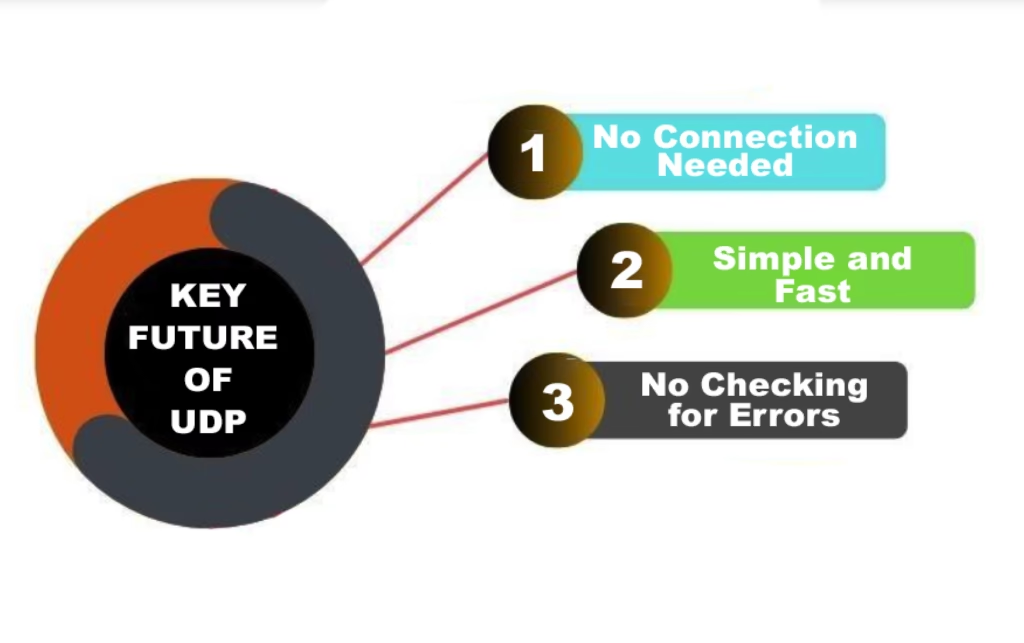The internet connects billions of devices around the world, helping us communicate easily. This is possible because of different communication rules called protocols. One of these is UDP, or User Datagram Protocol. But what does UDP mean, and why is it important? Let’s explain it in simple words so everyone can understand.
What Is UDP?
UDP stands for User Datagram Protocol. It is a key part of the Internet Protocol (IP) system and gives us a way to send data over networks. Unlike TCP (Transmission Control Protocol), UDP works differently and has its own strengths.
Key Features of UDP:

- No Connection Needed:User Datagram Protocol doesn’t need to create a link between the sender and receiver before sending data.
- Simple and Fast: It’s quicker and easier because it doesn’t need extra steps.
- No Checking for Errors:User Datagram Protocol doesn’t check if the data is received correctly or in the right order.
How Does UDP Work?

User Datagram Protocol splits data into smaller parts called datagrams and sends them one by one. Here’s how it works:
- Preparing Data: We break the data into smaller packets.
- Sending Packets: These packets are sent directly without waiting for a confirmation.
- Receiving Packets: The receiver collects the packets and processes them. If some packets are missing, the receiver doesn’t ask for them again.
Personal Experience: A Practical Look at UDP
A few months ago, I was organizing a live-streaming event for a community webinar. We used User Datagram Protocol to send the video to viewers. I noticed that even if some frames of data were lost because of network issues, the stream kept going smoothly without stopping. This showed me how User Datagram Protocol focuses on speed and real-time delivery instead of accuracy, making it perfect for such situations.
Another time, I was playing an online multiplayer game with friends. The game used UDP to send my actions to the server and other players. Even though some data packets didn’t arrive, the game still worked smoothly. This gave me a fun gaming experience without delays.
When Is UDP Used?
UDP is best for situations where speed is more important than perfect delivery. Here are some common uses:
- Live Streaming: Sending videos or audio where small data losses are better than delays.
- Online Gaming: Quick actions are more important than perfect accuracy.
- DNS (Domain Name System): Finding website addresses fast.
- VoIP (Voice over IP): For smooth, real-time internet calls.
Advantages of UDP
- Fast Data Transfer: No waiting for confirmations makes it quicker than TCP.
- Low Delay: Perfect for real-time uses.
- Simple Design: Easy to use in lightweight applications.
Disadvantages of UDP
- No Data Recovery: Lost data is not sent again.
- Not Reliable: Packets might arrive in the wrong order or not at all.
- No Built-in Security: User Datagram Protocol doesn’t include security features.
UDP vs. TCP: What’s the Difference?
| Feature | UDP | TCP |
|---|---|---|
| Connection Type | No connection needed | Connection needed |
| Speed | Faster | Slower |
| Reliability | Not reliable | Reliable |
| Error Checking | No | Yes |
| Use Cases | Streaming, gaming, VoIP | File transfers, emails, web browsing |
Using UDP in Programming
We can easily use UDP in most programming languages. For example, here’s how we can send and receive User Datagram Protocol packets in Python:
import socket
# Create a UDP socket
udp_socket = socket.socket(socket.AF_INET, socket.SOCK_DGRAM)
# Send data
server_address = ('127.0.0.1', 12345)
data = b"Hello, UDP!"
udp_socket.sendto(data, server_address)
# Close the socket
udp_socket.close()Conclusion
User Datagram Protocol is a useful protocol that focuses on speed instead of reliability. It’s not perfect for every situation, but it is essential for tasks like live streaming, gaming, and voice communication. By knowing its strengths and weaknesses, we can decide when to use User Datagram Protocol for our projects.
We hope this guide has made User Datagram Protocol easy to understand. Feel free to share your thoughts or ask questions in the comments below!



